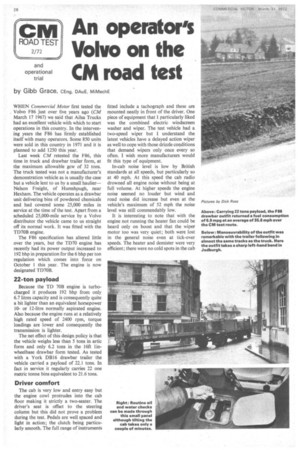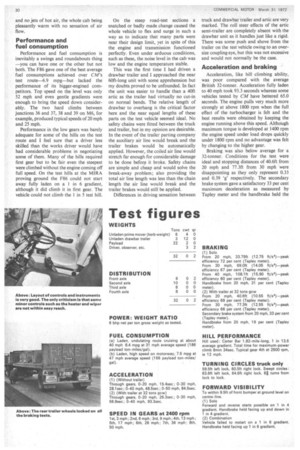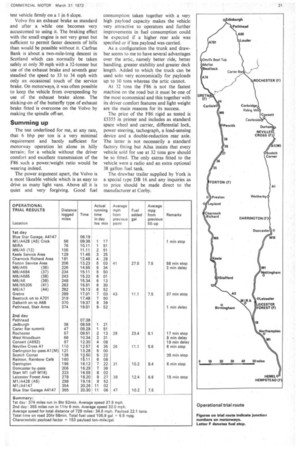CM An operators
Page 30

Page 32

Page 33

If you've noticed an error in this article please click here to report it so we can fix it.
ROAD T EST Volvo on the 2 72 and operational CM road test by Gibb Grace, CEng, DAuE, MiMechE
WHEN Commercial Motor first tested the Volvo F86 just over five years ago (CM March 17 1967) we said that Ailsa Trucks had an excellent vehicle with which to start operations in this country. In the intervening years the F86 has firmly established itself with many operators. Some 850 units were sold in this country in 1971 and it is planned to add 1250 this year.
Last week CM retested the F86, this time in truck and drawbar trailer form, at the maximum allowable gcw of 32 tons. The truck tested was not a manufacturer's demonstration vehicle as is usually the case but a vehicle lent to us by a small haulier— Nelson Freight, of Iltunshpugh, near Hexham. The vehicle operates as a drawbar unit delivering bins of powdered chemicals and had covered some 25,000 miles in service at the time of the test. Apart from a scheduled 25,000-mile service by a Volvo distributor the vehicle came to us straight off its normal work. It was fitted with the TD7OB engine.
The F86 specification has altered little over the years, but the TD70 engine has recently had its power output increased to 192 bhp in preparation for the 6 bhp per ton regulation which comes into force on October 1 this year. The engine is now designated TD70B.
22-ton payload
Because the TD 70B engine is turbocharged it produces 192 bhp from only 6.7 litres capacity and is consequently quite a bit lighter than an equivalent horsepower 10or 12-litre normally aspirated engine. Also because the engine runs at a relatively high rated speed of 2400 rpm, torque loadings are lower and consequently the transmission is lighter.
The net effect of this design policy is that the vehicle weighs less than 5 tons in artic form and only 6.2 tons in the 16ft linwheelbase drawbar form tested. As tested with a York DB16 drawbar trailer the vehicle carried a payload of 22.1 tons. In fact in service it regularly carries 22 one metric tonne bins equivalent to 21.6 tons.
Driver comfort .
The cab is very low and entry easy but the engine cowl protrudes into the cab floor making it strictly a two-seater. The driver's seat is offset to the steering column but this did not prove a problem during the test. Pedals are well spaced and light in action; the clutch being particularly smooth. The full range of instruments fitted include a tachograph and these are mounted neatly in front of the driver. One piece of equipment that 1 particularly liked was the combined electric windscreen washer and wiper. The test vehicle had a two-speed wiper but I understand the latest vehicles have a delayed action wiper as well to cope with those drizzle conditions that demand wipers only once every so often. I wish more manufacturers would fit this type of equipment.
In-cab noise level is low by British standards at all speeds, but particularly so at 40 mph. At this speed the cab radio drowned all engine noise without being at full volume. At higher speeds the engine noise seemed no louder but wind and road noise did increase but even at the vehicle's maximum of 52 mph the noise level was still commendably low.
It is interesting to note that with the engine not running the heater fan could be heard only on boost and that the wiper motor too was very quiet; both were lost in the general noise even at tick-over speeds. The heater and demister were very efficient; there were no cold spots in the cab and no jets of hot air, the whole cab being pleasantly warm with no sensation of air flow.
Performance and fuel consumption
Performance and fuel consumption is inevitably a swings and roundabouts thing —you can have one or the other but not both. The F86 gave one of the best average fuel consumptions achieved over CM's test route-6.9 mpg—but lacked the performance of its bigger-erigined competitors. Top speed on the level was only 52 mph and even gentle gradients were enough to bring the speed down considerably. The two hard climbs between junctions 36 and 37, 38 and 39 on M6, for example, produced typical speeds of 20 mph and 25 mph.
Performance in the low gears was barely adequate for some of the hills on the test route and I feel sure that a driver less skilled than the works driver would have had considerable problems in negotiating some of them. Many of the hills required first gear but to be fair even the steepest were climbed without the engine coming off full speed. On the test hills at the MIRA proving ground the F86 could not start away fully laden on a 1 in 6 gradient, although it did climb it in first gear. The vehicle could not climb the I in 5 test hill. On the steep road-test sections a snatched or badly made change caused the whole vehicle to flex and surge in such a way as to indicate that many parts were near their design limit, yet in spite of this the engine and transmission functioned perfectly. Even under arduous conditions, such as these, the noise level in the cab was low and the engine temperature stable.
This was the first time I had driven a drawbar trailer and I approached the near 60ft-long unit with some apprehension but my doubts proved to be unfounded. In fact the unit was easier to handle than a 40ft artic as the trailer had virtually no cut-in on normal bends. The relative length of drawbar to overhang is the critical factor here and the near equal lengths of these parts on the test vehicle seemed ideal. No safety chains were fitted between the truck and trailer, but in my opinion are desirable. In the event of the trailer parting company the auxiliary air line would break and the trailer brakes would be automatically applied. However, the coiled air line would stretch far enough for considerable damage to be done before it broke. Safety chains are simple and cheap and would solve the break-away problem; also providing the total air line length was less than the chain length the air line would break and the trailer brakes would still be applied.
Differences in driving sensation between truck and drawbar trailer and artic are very marked. The roll steer effects of the artic semi-trailer are completely absent with the drawbar unit as it handles just like a rigid. There was some push and shove from the trailer on the test vehicle owing to an oversize coupling eye, but this was not excessive and would not normally be the case.
Acceleration and braking
Acceleration, like hill climbing ability, was poor compared with the average British 32-tonner. Acceleration fully laden to 40 mph took 93.3 seconds whereas some vehicles tested by CM have bettered 65.0 seconds. The engine pulls very much more strongly at above 1800 rpm when the full effect of the turbocharger is felt and the best results were obtained by keeping the engine running above this speed. Althdugh maximum torque is developed at 1400 rpm the engine speed under load drops quickly under 1800 rpm and no advantage was felt by changing to the higher gear.
Braking was also below average for a 32-tonner. Conditions for the test were ideal and stopping distances of 40.6ft from 20 mph and 77.3ft from 30 mph were disappointing as they only represent 0.33 and 0.39 'g' respectively. The secondary brake system gave a satisfactory 33 per cent maximum deceleration as measured by Tapley meter and the handbrake held the test vehicle firmly on a I in 6 slope.
Volvo fits an exhaust brake as standard and after a while one becomes very accustomed to using it. The braking effect with the small engine is not very great but sufficient to permit faster descents of hills than would be possible without it. Carfrae Bank is about a two-mile-long descent in Scotland which can normally be taken safely at only 30 mph with a 32-tonner but use of the exhaust brake and seventh gear steadied the speed to 33 to 34 mph with only an occasional touch of the service brake. On motorways, it was often possible to keep the vehicle from overspeeding by use of the exhaust brake alone. The sticking-on of the butterfly type of exhaust brake fitted is overcome on the Volvo by making the spindle off-set.
Summing up
The test underlined for me, at any rate, that 6 bhp per ton is a very minimal requirement and barely sufficient for motorway operation let alone in hilly terrain; for a vehicle without the driver comfort and excellent transmission of the F86 such a power/weight ratio would be wearing indeed.
The power argument apart, the Volvo is a most likeable vehicle which is as easy to drive as many light vans. Above all it is quiet and very forgiving. Good fuel consumption taken together with a very high payload capacity makes the vehicle very attractive to operators and further improvements in fuel consumption could be expected if a higher rear axle was specified or if less payload was carried.
As a configuration the trunk and drawbar seems to me to have several advantages over the artic,. namely better ride, better handling, greater stability and greater deck length. Added to which the truck can be used solo very economically for payloads up to 10 tons whereas the artic cannot.
At 32 tons the F86 is not the fastest machine on the road but it must be one of the most economical and this together with its driver comfort features and light weight are the main reasons for its success.
The price of the F86 rigid as tested is £5355 in primer and includes as standard spare wheel and carrier, differential lock, power steering, tachograph, a load-sensing device and a double-reduction rear axle. The tatter is not necessarily a standard factory fitting but Ailsa insists that every vehicle sold for use at 32 tons gm should be so fitted. The only extras fitted to the vehicle were a radio and an extra optional 38 gallon fuel tank.
The drawbar trailer supplied by York is a special type DB 16 and any inquiries as to price should be made direct to the manufacturer at Corby.




















































































